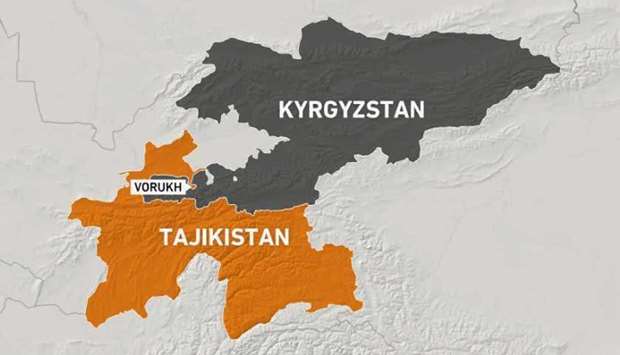Kyrgyzstan said Friday that 13 died and dozens of properties were burned during clashes with Central Asian rival Tajikistan, after a ceasefire agreed by the two countries hung in the balance following the heaviest fighting along their disputed border since post-Soviet independence.
Kyrgyzstan's health ministry said in a statement that 134 people were injured, of whom 13 died. Two of the injured are in serious condition and a girl born in 2008 was among the casualties, it said.
The country's national security committee said that three servicemen had died and 20 were injured.
Over 10,000 citizens had been evacuated from two districtsbordering Tajikistan where the fighting had been most intense, Kyrgyzstan also said.
The clashes that erupted along the border between the two poor, mountainous countries were the heaviest in years and had raised fears they might escalate into a wider conflict.
Local authorities in Kyrgyzstan's southwestern Batken region said that shooting along the shared border was still happening ‘periodically’ despite the ceasefire agreed on Thursday evening.
Military representatives of the two countries did not immediately confirm the information.
More than a third of the two countries' border is disputed, with the area surrounding the Tajik enclave of Vorukh, where Thursday's conflict erupted, a regular flashpoint over territorial claims and access to water.
- Kyrgyz properties burned –
Tajikistan, a closed authoritarian state, has so far acknowledged no casualties and no damages from the clashes.
Kyrgyzstan, in contrast, published a detailed list of properties in its Batken region that had been damaged.
Among the properties burned down during the violence were a border post, more than 20 homes, a school, eight shops and a casino, according to the emergencies ministry.
The ministry said a state of emergency was in force in several villages and their surrounding areas on the border.
‘Local villagers have been evacuated to a safe place,’ the ministry said.
Over 10,000 citizens evacuated from villages at the centre of the conflict have been ‘placed in specially organised points’ in Batken's administrative centre, ‘or went to visit relatives’, according to authorities in the Batken region.
Military units from the two countries began exchanging fire on Thursday, but later that day a ceasefire was announced by Kyrgyzstan's foreign ministry from 8:00 pm (1400 GMT), with armed forces returning to their bases.
Tajikistan acknowledged the ceasefire in a statement published by its state information service early on Friday, saying the two sides ‘came to a mutual agreement to end the armed conflict, to withdraw personnel and military equipment to places of permanent deployment’.
Tajikistan's national security committee had earlier on Thursday acknowledged that two citizens had been admitted to hospital, with one in a serious condition.
Its security committee accused Kyrgyz soldiers of opening fire on Tajik troops at the Golovnaya water distribution point, located on the Isfara River.
It said Kyrgyz and Tajik civilians had become embroiled in a dispute over river infrastructure on Wednesday.
Border disagreements between the three countries that share the fertile Fergana Valley -- Kyrgyzstan, Tajikistan and Uzbekistan -- stem from demarcations made during the Soviet era.
The knotting, twisting frontiers left several communities with restricted access to their home countries.
Uzbekistan, the most populous country in the region, offered on Thursday to help mediate the conflict.
Russia, a strategic ally of the two rivals, said it was monitoring the conflict.



